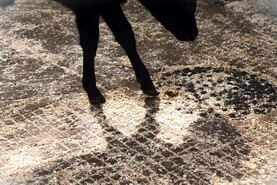Silage
Farmers that planned a late second cut or a third cut of silage are looking at cutting these fields over the next few weeks. Making silage in the autumn is harder than the summer. There could be a lot of ‘soupy’ silage made over the coming weeks. The first thing to note is that nitrate levels are higher than normal this autumn, as there is more nitrogen available to the plant – both from what was applied and what is available in the soil. High nitrate levels affect the buffering capacity of silage. Basically, the pH won’t drop. Normally, a good wilt will elevate the sugars and overcome the nitrates, but the opportunities for wilting now are poor. Even on dry mornings there is a dew until midday and the evenings are closing in also. For best results, try and get two dry days together and cut in the middle of the day. If using a conditioner mower, ted it out the following day and pick it up that afternoon. If using an ordinary mower, ted it out after mowing. Acid- or sugar-based additives will help with preservation if nitrate levels or moisture content is very high. When to cut depends on the cover of grass on the silage fields and how soon you need the grass back for other stock. It’ll take at least three weeks for grass to recover enough for even a light grazing. This means that it’ll be mid- to late-October before fields cut this week can be grazed again.
Fertiliser
I know cash is scarce on a lot of dairy farms, but what if I said you could buy next years’ silage now for a fraction of the price. I’d be making an educated guess that over 90% of silage fields in Ireland are deficient in both lime and potash. Now is the best time to spread both. The lime will cost about €23/t delivered and spread. Spreading 2t/acre will cost €46/acre. Muriate of potash (MOK 50%) is costing around €340/t. Spread potash now to build up soil fertility. Spreading one bag/acre will cost €17/acre and over a few years it’ll lift the soil index. The return from lime and potash will be extra trailer loads of silage next summer. There are still two weeks left to spread nitrogen and phosphorus on grassland before the start of the closed period. There is a good economic response to nitrogen in the autumn. On reasonably dry farms, I would blanket-spread the farm at a rate of one unit of nitrogen/day to get you to the end of the month and then go with 20-30 units/acre on the last day of September.
Calves
Dairy heifer calves should be in or around the 200kg liveweight mark now, or around 35% of their mature liveweight. This is a really important time to sort out the light calves. Put them in a group of their own and feed them meal and nicer grass. Some will run them on ahead of the bigger bunch. This is okay, provided the balance is right and both groups are moving regularly. Whether or not to go in with meal depends on weights relative to targets. Remove any bull calves from heifers and either squeeze them or keep them away, as some weanlings are showing bulling activity.






 This is a subscriber-only article
This is a subscriber-only article









SHARING OPTIONS: